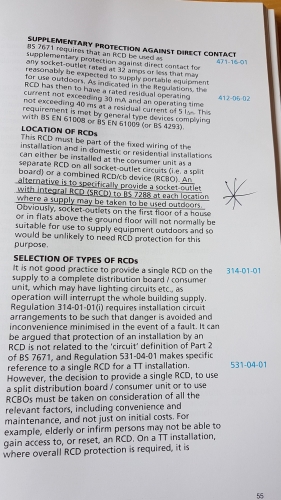Hang on Andy,
The change was advertised quite clearly, on Page 5 of BS 7671, which says that Chapter 53 has been completely revised.
Regulations 531.3.4.1 and 531.3.6 are definitely included in that.
the installer must ensure that such devices can provide isolation in accordance with Regulation 531.1.1
AJJewsbury:
Hang on Andy,
The change was advertised quite clearly, on Page 5 of BS 7671, which says that Chapter 53 has been completely revised.
Regulations 531.3.4.1 and 531.3.6 are definitely included in that.
But no-one went around saying "Big change in the 18th - RCD sockets/FCUs no longer permitted" - so I still reckon it was easy to overlook that particular implication (unlike SPDs or AFDDs).
the installer must ensure that such devices can provide isolation in accordance with Regulation 531.1.1
I've been wondering about what exactly was meant by "Devices for protection against electric shock by automatic disconnection of supply shall be suitable for isolation..."
Do they mean that if ADS is activated that the circuit must be automatically and immediately isolated (so 3mm+ contact gaps, also disconnecting N in TT systems etc) or just that the same device used for ADS can also be used for manual isolation.
For instance, with fuses I can easily ensure a 3mm gap by pulling the fuse out, but I'm not sure I can if the fuse blows of its own accord (thinking of rewireable fuses, while the fusewire often vapourises entirely, sometimes you just end up with a small break).
And (depending on what we decide 'low resistance' of 461.2 means) is this the end of SP switching RCBOs (and possibly single pole MCBs too).
If it's just manual isolation is needed, then things get a lot simpler.
- Andy.
Further, the change has (apprently) been made to the product standard in 2016 (between 17th AMD3 and 18th), removing the requirement for the RCD in the product to provide 3 mm isolation, and a resulting number of changes to the Scope - i.e. a MAJOR change to the use-case. Where was that advertised to the industry?
mapj1:
Indeed, and even if they do not meet the letter of the current standard as written, an RCD socket or spur is a good way of performing a cost-effective addition of a stair lift or whatever, such that the new bit is protected to a level equivalent to current standards, while the rest is no more dangerous than it was the day before.
One of the unintended consequences of regulation changes and restriction as to what is permitted, pushes up costs and in turn that does mean that the old stuff we were trying to get rid of tends to stay in service longer .
I fear that those informing the committees, live in million pound houses in the South East, all have TNC-s or TNS supplies, and think nothing of a few hundred quid here or there. Reality is that further from the centre, there is TT, there are fused neutrals, and 50 year old wiring is very much still in service on BS3036 fuses, and a CU change is an expensive luxury that may have to wait it's turn.

We're about to take you to the IET registration website. Don't worry though, you'll be sent straight back to the community after completing the registration.
Continue to the IET registration site